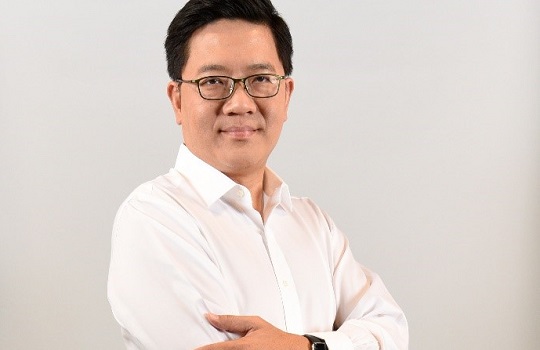
When I think about it, the best service we can give as a government agency is one that is as seamless and invisible as possible, especially at different key moments in citizens’ lives.
As one of Asia’s premier innovation hubs, it is perhaps little surprise that the Singapore Government has absorbed much of the commercial sector’s digital nous, consistently ranking among the global Top 10 for eGovernment. However, such progress would have left wanting without significant push from tech trailblazers from within government.
Dominic Chan has been a leading light for the progressive transformation of Singapore’s public sector services. As Director of Singapore’s digital citizen services agency, Moments of Life, Chan has led an ambitious centralisation program, with a mission to consolidate more than 500 separate citizen services spanning the government, whilst also serving as mentor and luminary for his young innovation team.
FST Government sat down with Chan recently to explore Singapore’s ambitious all-in-one citizen services platform, LifeSG and lessons for Australia in building predictive, accessible, and ethical government services – ones that are there for each touchstone of a citizen’s experience: those crucial moments of life.
FST Media: Moments of Life stands as quite a unique name for a government agency. Tell us a bit about how Singapore came to choose this title.
Chan: The whole idea behind our agency’s title is such that, when we think about government services, they’re very different from those consumed by citizens in the private sector. People don’t come to the government when they want to – they come when the need arises. And these needs usually evolve around key moments in your life.
Having joined Singapore’s GovTech two and half years ago, one thing that really drew me to this work was its capacity to transform services and make lives better for citizens. When I think about it, the best service we can give as a government agency is one that is as seamless and invisible as possible, especially at different key moments in citizens’ lives.
Core to what my division does is about rethinking this entire experience and finding a way to simplify this as much as possible.
By bundling and consolidating related services and information together, delivered through a personalised experience, we hope citizens can get through these key moments as quickly as possible and focus on what really matters to them.
While our app, LifeSG, was renamed from ‘Moments of Life’ last year, the division still continues with our former name. We believe that, to our core, what we’re doing – not just with our LifeSG app but also all the other products we’re responsible for – is all about helping citizens through their key moments of life.
FST Media: You’re been a leading proponent of design thinking in government. How has the methodology inspired innovation within MoL?
Chan: Design thinking is not something new; it’s been around since the 60s or 70s. It consists of going through iterations of divergent and convergent thinking and, effectively, bringing these together.
When we think about improving and innovating from where we are today, this is the methodology we use. In order to apply this methodology and make it easy to understand, we’ve done three key things.
Number one, we want our team to feel empowered. For this, we first need a way to organise people together, creating a cross-agency task force that enables people to participate from the ground up. As far as possible, we also want to make it as accessible as possible; we don’t want people to feel that design thinking is something only meant for UX designers.
Number two is cross-agency participation – something I consider vitally important. I spend a significant proportion of my time not only on the tech part, but also in coordinating various agencies, collaborating with various workgroups as well as committees, to look at a particular moment in the life of a citizen – to imagine a persona and design relevant services around that.
Thirdly, when we collaborate, it’s also important that everybody speaks the same language.
When we started this journey some time ago, Singapore’s various agencies were excited when we raised our core narrative about coming together to do good for people.
Every agency has a different methodology or different thinking on how to approach this problem – even two different agencies applying design thinking may use slightly different terminology. We unified the language, so that when we went into any discussion, it was a lot more efficient. With that, we were able to spread the word and get momentum beyond just a few life moments.
Today, apart from some of the key moments that my team and I are driving, a number of agencies are also springing up different initiatives and coming to us to collaborate and potentially host services together with LifeSG.
So, in sum, these are the three things we’ve done: empowering our team, enabling cross-agency participation, and standardising how we do things.
FST Media: You hinted at cross-agency collaboration. Obviously, there are considerable issues with stakeholder buy-in for these projects and, at times, resistance to more out-of-the-box innovations. How do you overcome that resistance and ensure universal acceptance?
Chan: That was a key concern when we started this journey. Many agencies today are really quite efficient in what they’re doing; the Singapore Government has some repute for its efficiency. However, we need to help them understand that that’s not necessarily good enough – awareness is the very first step to change.
To make sure people understand this, we have to narrate the problem for them. We need to show that efficiency is not enough because, today, our citizens get to experience a range of services from the private sector, some of them may be better developed and delivered.
For the government to remain relevant to them, it is extremely important for us to understand that there is still a gap and an opportunity for us to improve.
A lot of convincing was needed initially. Two years ago, in 2019, my team organised an annual public service transformation conference and, in the course of that, we were able to explain to the audience what we’re trying to do. These conferences were key to helping spearhead these initiatives, both in running on the ground, and in talking to people to make sure they understood. And, if any opportunities present themselves, we will broadcast and explain what we’re trying to do.
Within this messaging, we incorporate some examples of existing pain points that we’re hearing from citizens, as well as examples of success. This helps inspire fellow public officers to see that they can do better than what they are doing today.
FST Media: As something core to your mission, how would you define a seamless government interaction?
Chan: Seamlessness, essentially, is achieved through user centricity – that is, putting users at the centre.
To us, seamlessness has a few modalities. Number one is what we deem omnichannel. In this, we mean citizens don’t have to repeat whatever they’re doing if they traverse from channel to channel – it’s a very common experience we hear from people around the world when visiting a government website or portal. Naturally, there will be escalation to a hotline or chatbot, and sometimes a service will require the citizen to turn up at a physical service centre. Nevertheless, the common frustration that people have is a need for them to repeat their story over and over again.
For that matter, an individual may consume a set of services that are related but provided by different agencies. And when they move from one to the other, they need to feel like that the whole journey is smooth and continuous, and not disrupted along each step of the way. That’s what I consider to be seamlessness.
When we started consolidating everything into one single app, we actually did user research, both quantitative and qualitative, and tested a different type of product approach with the public. Around 500 users were consulted. From this, we learned that citizens face three main problems when interacting with the government.
One is that information and services are usually quite siloed – they have to go to multiple places to get what they need.
Number two is on discoverability. In the past, if you talk to someone about doing things with the government, the common response is that they’ll either Google it or ask a friend who has recently been through the process; that’s fine, but they’re not the authority or the original source of information.
And the third is a lack of awareness. There are times when people simply don’t know that they have access to certain public services or benefits. Government, ultimately, wants to do good for its people. However, by the time we go through and translate the various policies for public consumption, no matter how we publicise it, too often the public is still not aware of it or doesn’t recognise that such a thing is directly applicable to them.
FST Media: To pick up on that point of citizens being unaware of the benefits they are entitled to. Could you see a point in the near future where you’re delivering predictive government or one that at least prompts citizens to engage in relevant services to them?
Chan: The key to delivering predictive services is to first solve the problem of delivering true ‘personalisation’.
We cannot think of every citizen or customer that comes through the door as a generic person that is here for a single thing. Each time a member of the public approaches the government, they’ll have something unique about what they need.
How do we try to understand that and help them in a way that they don’t feel like they are just a product out of the factory?
It’s the same problem we see with regard to information and services being siloed. The logical thing to do is put everything together, but across the whole of the Singapore government, there are more than 500 different services. If you put everything together in a single place, it would be extremely confusing and difficult for people to consume. This is where personalisation becomes very important.
FST Media: So would you consider LifeSG a kind of one-stop-shop for government services?
Chan: Correct. Though I would more refer to it as a citizens’ assistant: after all, it’s something that people can carry around with them and when there’s a need to consume certain services, they can fire the app up, and based on the profile that they’ve created, the algorithm will consider what may be most relevant to them, putting that forward in a more personalised fashion.
The app is still in a continuous development phase, because we have, as I mentioned, about 500 different government services. Currently, we are only about one-fifth of the way there – however, we’ve covered most of the key moments of life. It’s now a process of onboarding digital services and expanding further to link them all together.
The app has some personalisation capability, based on information from government sources or which citizens have provided to the government. For example, from the age group they’re in – retrieved by logging in with Singpass, Singapore’s trusted national digital identity – we are able to offer them tailored information on relevant family-related or work-related topics. We also have virtual intelligence that allows citizens to interact with a chatbot if there is further clarification needed.
The next phase of our work is to make sure that when citizens pop from one service to the other, they can connect directly. In Singapore, there is also an Integrated Public Service Centre, where we put together front office services at a single location.
Over the coming year or so, that will also be integrated into the whole family, with the entire experience going from a digital front through to something that is a very interactive, face-to-face channel.
This is the state we’d want to achieve in about a year to two from now, with people traversing from one touchpoint to the other in a continuous experience.
FST Media: And will the chatbot be integrated into the LifeSG app?
Chan: My team is also responsible for a whole-of-government chatbot platform, available on most Singapore government websites. We are now integrating all the information and knowledge from different agencies into a central platform to deliver what we call a ‘no wrong door’ policy; which means that citizens can go to any channel and ask the chatbot questions, and it will return relevant responses by scouting across all government agencies on behalf of the user.
After all, a citizen sees us as one government. They may not fully understand or may approach the wrong agency or channel – this information, however, should still be available across any channel.
Once this ‘super chatbot’ is ready, the natural point to serve it is through LifeSG.
If there’s a need that the chatbot cannot completely answer, then there’s an escalation process, routing the user to a live conversation with an actual officer or personnel, who can address the question conveniently and help users complete their transaction.
FST Media: Jumping back a little to the personalisation play. There is no doubt a bit of a tension between the need to preserve citizen privacy and ethical best practice whilst also leveraging all available data to enhance the citizen journey. How is your team resolving this tension?
Chan: This balancing act is very important.
Citizens count on government to deliver quality services to them, while at the same time each citizen counts on government to maintain their privacy to the highest possible standards.
We, therefore, see the most important thing is being as transparent as possible.
We need to adopt a few key principles. Number one, we must first seek permission. When a user logs in to the app, if we draw information from a central repository for them, we first need to ask for permission, stating clearly the app is going to draw some information to serve you – the citizen – better. In this, the user must consciously agree to go through that process. Number two, we have to be very transparent in how we apply this information. When we push recommendations and explain the why and the how. For instance, we will state clearly that it is because you have a child in school, that’s why we’re talking to you about this or, because you own a car, that’s why we’re talking to you about that. It’s about being respectful, asking for permission whenever we consume certain things, and being very transparent in explaining how data is being used. We continuously need to bear this in mind as we navigate the progressive development in personalisation.
FST Media: So just about every government across the world is progressing to digital government – and no doubt in Australia we’ve made some fairly strong progress. Would you have any advice for us, based on Singapore’s experience, on what we can do to craft better eGovernment services?
Chan: I think the learning has always been mutual. When we started this journey, we were also learning from our peers in the Australian Government. Of course, our terrain is quite different, especially when we talk about Covid – you have such a huge population and space, whereas we are a small island nation with easy-to-control borders. But perhaps I can summarise a few key learnings.
Number one, individual agencies tend to already have good digital initiatives. However, getting everybody together is the most important part; the technology aspect is probably the easiest. To do so, we must first create awareness that nurtures an impetus to change and ensure that, technically, everyone speaks the same language to maximum ease of collaboration.
Speaking with counterparts in other countries, many agree that the focus should be on finding a common narrative or objective to pull all government agencies together.
If we put the citizen as the topmost priority, suddenly you start to find you can build alignment across agencies much easier.
FST Media: Inspiration often comes from unlikely places. Who or what has most inspired you through your career and perhaps shaped your management style?
Chan: It’s very difficult for me to put a finger on a single person. Throughout my entire adult life, I always look out for what’s good in all people I work with; I’ve learned a lot from everyone I’ve interacted with. I don’t think I’m someone who is particularly influenceable by a single person. I do, however, tend to draw experiences from people that I work with; that has been helpful to me in terms of gaining a broader perspective and learning things from individuals from all walks of life.
This has had two major impacts on where I am today in this current job. One is that I’m able to understand and relate to people’s problems easier, because I constantly try to understand and see things from people’s point of view and internalising it. Secondly, having spoken to a lot of people, and having experienced and analysed my own interactions with the government, I find my work to be extremely inspiring. I don’t have a single person; for me, it’s a combination of many, many life experiences and people that I meet on a daily basis. ◼





